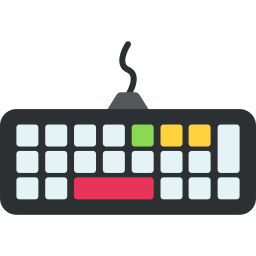
Keyboard – External & Peripheral Hardware
A keyboard is one of the most fundamental external and peripheral hardware devices used in computing. It serves as a primary input tool that allows users to enter data, issue commands, and interact with software applications through a series of keys arranged in a specific layout. Typically connected to a computer via a USB cable, wireless dongle, or Bluetooth, the keyboard is essential in nearly all computing environments including offices, homes, educational institutions, and industrial systems.
Keyboards are designed for versatility, offering a range of features and styles to suit different user needs, from simple typing to complex command execution. They are compatible with nearly all desktop computers and laptops, and are often used with tablets, smart TVs, and mobile devices as well.
Key Features and Characteristics of a Keyboard:
Consists of a set of keys that include letters, numbers, punctuation marks, function keys, and control keys such as Shift, Ctrl, and Alt
Available in full-sized versions, compact layouts, and ergonomic designs for comfortable long-term use
Comes in two main types: membrane keyboards, which are quiet and low-cost, and mechanical keyboards, which provide tactile feedback and durability
Wireless keyboards provide flexibility and portability, while wired models offer consistent performance without the need for batteries
Many keyboards include multimedia keys for volume control, play/pause, and quick access to common functions
Ergonomic models are designed to reduce wrist strain and improve posture during extended use
Gaming keyboards may include RGB lighting, programmable keys, and fast-response switches
Compatible with operating systems such as Windows, macOS, Linux, and Chrome OS
Some models include spill-resistant designs or are made for specific environments like industrial or educational use
Common Applications of Keyboards:
Typing emails, reports, documents, and messages in personal and professional contexts
Navigating operating systems and executing software commands through shortcut keys
Coding and programming tasks that require the input of structured text and symbols
Controlling games, especially in PC gaming where precision and speed are important
Data entry tasks in administrative, accounting, and retail environments
Content creation such as blogging, writing, and editing digital media
Supporting virtual communication via chat platforms, email clients, and online collaboration tools
Facilitating remote work, online learning, and virtual meetings
Used in customer service roles and call centers for recording and processing information
Accessible for users with physical challenges through alternative layouts or on-screen keyboards
Cost and Accessibility:
Keyboards are generally low-cost devices and are widely available in various price ranges
Basic wired keyboards are very affordable and commonly bundled with desktop systems
Wireless keyboards and those with specialized features tend to be more expensive
Mechanical keyboards, often used by professionals or gamers, are priced higher due to build quality and longevity
Most keyboards are a one-time purchase and do not require ongoing costs or subscriptions
Some specialized keyboards include software for customization, typically provided for free
On-screen virtual keyboards are included with most modern operating systems at no additional cost
Battery-operated wireless keyboards may incur minimal recurring costs for battery replacement or charging
Widely accessible in physical stores and online markets, making them easy to replace or upgrade
Comparison with Other Input Devices:
Compared to a mouse, a keyboard is better suited for tasks involving text entry and command input
While touchscreens are useful for basic interaction, keyboards offer more accuracy and speed for typing
Voice input is helpful for short commands or dictation but lacks the precision and versatility of a keyboard
Compared to stylus or handwriting recognition, keyboards remain more efficient for extended writing or programming
Keyboards provide more comprehensive control over a system than gaming controllers or remote inputs
Unlike trackpads, which are compact and limited in function, keyboards offer full input capabilities for all applications
Conclusion:
The keyboard remains an essential and irreplaceable component of modern computing hardware. It supports a wide range of activities from basic text entry to advanced software development and digital communication. With options available for every budget and purpose—whether for office work, gaming, education, or accessibility—keyboards continue to evolve while maintaining their fundamental role in computing. Despite advances in voice recognition and touch-based interfaces, the physical keyboard is still the most efficient, precise, and reliable method of input. Its continued relevance is a testament to its simplicity, functionality, and adaptability in a constantly changing technological environment.












